S C H O O L • O F • A R C H I T E C T U R E • M C G I L L • U N I V E R S I T Y
S U M M E R • C O U R S E • I N • GR E E C E • 2003
Professor Ricardo L. Castro, MRAIC


Introduction. Summer Course 2003 has conceptually started today. Most of the participants in the course gathered this mornng at the School of Architecture. Everyone obtained his/her airline tickets and insurance packages as well as three required reading articles. Meeting time at the airport on the day of departure was established at 4:00 p.m., two hours before take off for Toronto where we will connect with Austrian Airlines. See you all at Dorval at that time next Saturday! RLC
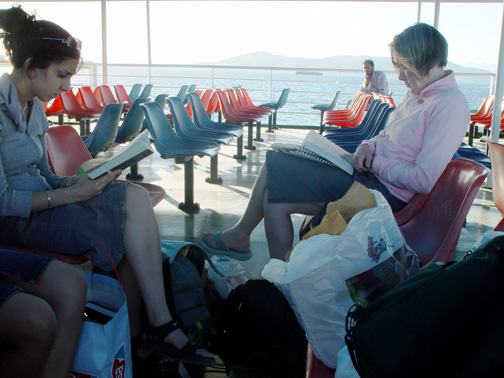
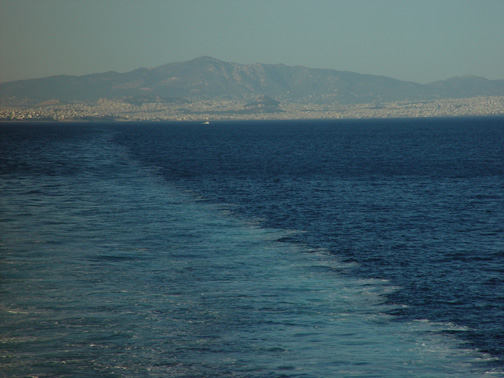
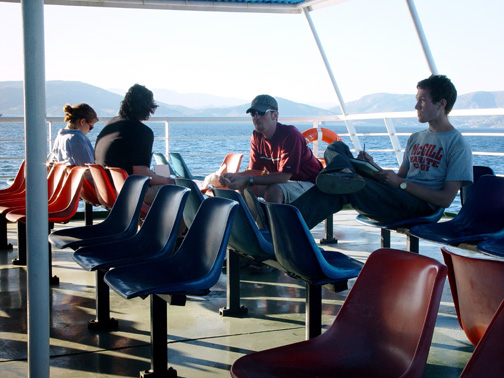
AEGINA
POSTING: 8 May 2003
Our flight to Greece went well with the exception of two or three unexpected--but resolved successfully--events: no apparent bookings for half of the group at Dorval due to a computer failure(?) and a similar situation with the hotel reservations in Vienna. Despite these minor problems, we all made it safely to Aegina. Monday the 5th was all invested in our travel from Vienna to Aegina (plane-bus-ferry-taxi). The following day was free to allow everybody to familiarize with the locale while I went to Athens to obtain the required papers to access archeological sites and museums as a group and to be able to guide in them. Yesterday, we visited Kolonna, the ancient city, site of the Temple of Apollo, located some 500 meters from the hotel. This marked the beginning of our explorations and course activities proper. From now on, a different member of the group will be writing the daily posting.
RLC
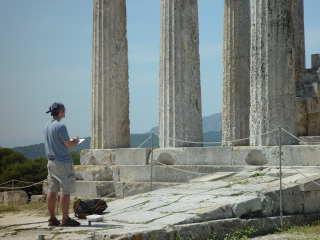
The afternoon was for us an extra-long siesta during which we slept, swam, read and caught up on some work - a welcome break from the intense site observations of the past few days. We met in the evening for our session, but instead of our usual poolside meeting, we congregated at the cove just down the hill from our hotel. We sat on the L-shaped concrete pier there, facing the shore, where our classmates presented to us their mythological characters. A small pool of water, fed by the sea, separated the audience from the 'chorus' of our own little theater. We learned about, very appropriately, Greek tragedy, Prometheus (creator of man) and Poseidon (god of the sea). The sun set on the water in this setting of splendor as we contemplated our proximity to - whether it was ancient Greek or otherwise - divinity.
Andrea Tsang

POSTING: 9 May 2003
I like to refer to today as if it were a story,almost a way to connect two great bodies of beings, one whom is a figment and/or a necessity for the other. These two entities that I refer to are man and myth. This course has started with the intent to not only have us learn the definition of the myth but also to understand what the myth is in its essence and why it is re-occurent and necessary in mankind's evolution. Man needs myth in order to answer his question and give life meaning and purpose.
I would like to further explore the connection between man and myth. Today was a good day to begin, you will soon see why.
The morning visit was the Kolonna Site which are the ruins of what used to be known as the temple of Apollo. We first wandered around the museum full of artefacts. It was especially amazing to see the progression in the pottery from geometric patterns to specific myth related topics. These vessels were used everyday by common people. This struck me as fascinating because in itself it meant that myth was something which was known and very present to everyone. It seemed as if myth at this point of time grew increasingly important for people to remember, needing a reminder everyday in the form of pottery. It was almost a security blanket assuring no one would forget the myths. The progression from geometric to myth related oriented pottery shows the relationship between man and myth evolving with time, and its growth in importance.
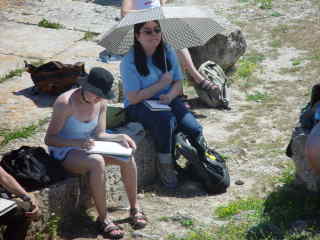
As we sat within the site later on that morning, I began to feel my connection with the site and with myth. I imagined how the Greeks would feel when approaching this magnificent temple and how they would feel towards this God that they so venerated. In a way, I felt amazed just as the Greeks did, except for me the Greeks were the myth.
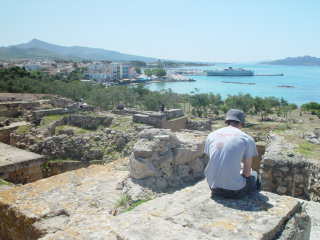
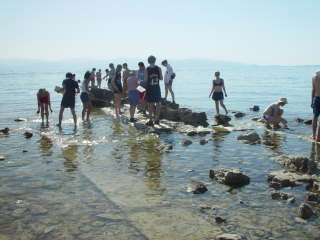
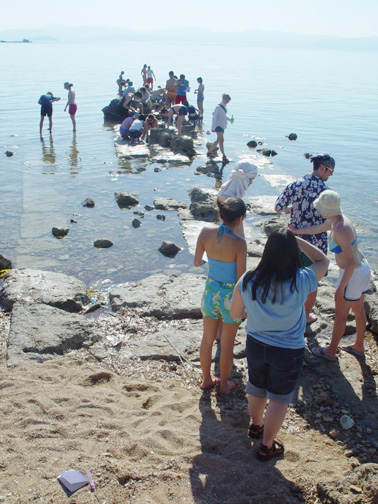
When the sun got a little weaker, we took the Panathenaic path to the Acropolis. This path was designed recently by Greek Architect Pikionis who planned it, using ancient and recent stones in a precise and delightful pattern. We climbed the Acropolis to find that the temple of Nike Apteros had disappeared! We heard about restorations but we preferred to believe some Greek Gods had tricked us! The temple of Athena Parthenos, the great Parthenon, emerged impressively as we climbed the steps of the Acropolis. This enormous temple from the classical period is still being restored today. Used in the 16th century by the Turks to store powder, it was struck by the destructive lightning and later bombed by the Venetians. Its presence is by itself very impressive. We explored the incredible site and were delighted by the Erechtion and its famous Caryatides, these carved maids carrying on their head for centuries the precious carved marble blocks. On the Acropolis there is a museum possessing many statues, sculptures, and friezes removed from the surrounding temples to be protected from the damaging atmospheric pollution. We spent the rest of the afternoon caressing stones, hugging columns and sketching this magnificent site. We headed back to the city's metro and encountered the Royal Guard, guarding the tomb of the unknown soldier on Constitution square.

Tired and sun-tanned (sun burned for many..) we took the ferry back to Aegina for a late dinner and some well deserved sleep. We all went to sleep cherishing these great souvenirs from sites we have been looking at in books for years.
Roxana Gauthier
POSTING: Aegina, Sunday 11 May 2003
This Sunday was the first hike we were to embark on this trip. We started at an early 9 o'clock with a bus that took us away from the coast and into the hills of Aegina. From there, we started walking up, past the "Moni Hrysolentissas" monastery, and to a plateau. There, we found a small white church and a small cistern carved into rocks nearby. From that place, we could see our objective in the distance: Mount Oros. We advanced into the plateau, and before descending, some of us climbed a small rocky peek in the vicinity. We walked down into the valley before Oros and stopped at the unexcavated ruins of an ancient temple at the foot of the Mountain. There was a church under restoration at the site as well. The break was long to allow for the sun to become more bearable. We then undertook the rather straining ascent. After that physical test passed, we reached the chuch at the peak. We all rang the bell as a testament of our achievement, but we were also rewarded with the greatest view of Aegina, Mount Oros being the tallest peak on the island. Our spirits were taimed when a crew of old clergyment made it to the top shortly after us without breaking a sweat. Humiliation aside, it was a great moment. After an hour, we walked down using a much longer route, and reached Perdika, the southernmost town on Egina. There, we rested at a cafe until the bus arived, and took us to our hotel. We had finished the longest hike of our journey, and it was only 8pm.
Victor Simion
POSTING:Aegina, Monday, 12 May 2003
Today, under yet another drastically hot Mediteranean sun, was a SCG 2003
National Holiday. For most of us this meant National Laundry Day. All of
our balconies, as well as the lawnchairs around the pool, were littered
with the clothes we have accumulated over the past eight days. Thankfully,
the chore did not occupy all of our day off, many of us went to town for
lunch and scope out the shops, others chose to work on their sketchbooks
and few even rented a car to explore this marvelous island before taking
off to other destinations for two weeks. Our day was completed with our
second meeting on a big rock on the sea, watching the sun set behind the
rocky landscape. Overall, it was a productive yet relaxing day for most of
the crew.
Stefania Minotti
POSTING: Aegina-Delphi, Tuesday 13 May 2003
Today was a quite interesting day. We started off with a traditional ferry ride to Athens, which in todays case would lead us to our magical tour bus that would be our new home away from home.Upholstered with 70's style fabric and bright orange curtains, the group became enthusiastic to spend the day with the insects that were ever so abundant in the bus. Actually, the bus was not that bad, it had reclining seats and air conditioning,I mean you cant have everything!
The first stop of the day was a lunch stop in the city of Distomo. Within this city was a small site that we were going to visit after lunch. This site contained a monument that was perched upon a hilltop.The story behind the monument evoked somber emotions throughout the group. Basically the monument was build in in memory of the families and children who were murdered by the Nazi's on June 10th 1944 due to their retalliation against te movement. Besides the symbolic atmosphere created by the monument, there was and amazing view of the mountains.There was also a glimpe of an interesting housing project done by a group of architects known as Atelier 67.

Our second stop was the Monastery of Hosios Loukas. This stop was definately the highlight of my day, Built on the west slopes of Mount Helikon,the monestery displayes amazing frescos and mosaics that dated back to the 11th century.Within the compound there were many places where one could absorb the beauty of the Architecture.Inside the churches, the whole ambience created by the stucco walls that were dematerialised by golden mosaics was simply spectacular.Personally the exerience rekindled my spiritual side, and in effect refreshed me and made me appreciate being given the oppertunity of experiencing such a splendid place.
Our final stop was on its way, destination Delphi.On arrival, we made a mini stop at the entrance to the city,where the group purified themselves in the water of the Castilia Fountain.We then proceeded into Delphi in our cute/hippie/nauseating bus and unwound in our new hotel.
Peter Moses
POSTING:Delphi,Wednesday 14 May 2003
Delphi and the ancient sites that surround the renowned oracle were the focus of our group's explorations today. We commenced the morning with a tour of the site which was originally dedicated to Apollo. Climbing the sacred path through the ruins, we investigated numerous treasures, the temple of Apollo, of which only a few columns remain, a theater, and an ancient stadium. The site was characterized by interventions from many eras, the classical period, Roman times, and of course modern tourist oriented modifications.
Although the site was congested with tourists, it struck me that Delphi was one place where tourists were nothing new. In ancient times, Delphi, an internationally renowned oracle, was the destination of many peoples, both Greek and “barbarian, from king's messengers to lowly peasants). In fact, the Greeks considered Delphi to be the center, or navel, of the world, “Omphalos in Greek. Therefore, the attraction and consequent congestion was nothing out of the ordinary, and were most likely characteristic of ancient times, minus the tour buses of course.
My second reaction to the site had much more to do with the mythological aspects of Delphi. Professor Castro has been urging us to think about the relationship between the architecture that we are investigating and another aspect of the course, mythology. The two converge at Delphi on many levels, the most obvious being the connection between the Oracle of Apollo and the architecture designed to facilitate communication between the god and man. I thought that there was also a connection on a different level, that of the Apollonian/Dionysian dichotomy. These two deities represent a duality that comes up again and again in Greek mythology as well as in life, the divide between wisdom and serenity, symbolized by Apollo, versus the chaotic, untamed and instinctual characteristics that embody the spirit of Dionysus. The rugged and wild mountains that encircle Delphi were a sharp contrast to the perfection embodied in the construction of the walls and columns of the sanctuary. This became most evident to me when I looked at the contrast between the columns of the temple of Apollo, vertical symbols of planning, wisdom and perfection versus the jagged and random formations of the mountains behind. This dichotomy was also evident in the state of the site. All the temples and treasures we saw today were in a state of decay; once being fully realized projects, the site now contains pediments strewn about, chipped rocks and foliage growing in between the gaps in the once perfect classical walls. The intrusion of these untamed, illogical forces into the site further demonstrates the duality of Delphi.
To me Delphi brought to life some of the concepts that we have been talking about in our frequent discussions. The site materialized the two opposing mythological forced of Dionysus and Apollo through architecture and its relationship to landscape and time. Yet what was most striking to me was the harmony this contrast generates. Delphi was a very peaceful place, even amongst the crowds of tourists, demonstrating that the ancient Greeks realized that both these forces were important within the world and when combines can create a very prefect place.
Nathaniel Lowbeer-Lewis
POSTING: Delphi, Wednesday 14 May 2003
We will try to make up for the four days of silence. Lately, everything has been hectic but eventually worked out according to plan. We began our 15 day trip of the Peloponese and Santorini yesterday and had the opportunity of visiting the Byzantine Monastery of Ossios Loukas (10-11thC)proceeding subsequently to Delphi. There will be additional postings later on today, probably accompanied by photographs.
RLC
POSTING: Delphi-Kalambaka, Saturday 14 May 2003
The tenth day of our sojourn began with a six-hour bus ride to Kalambaka, where the prodigious 'suspended rocks'(Meteora are located. Pity for those who drank gallons on the night before- hell was the bus ride on the long, winding roads from Delphi. However, the nausea was much alleviated by a sweet siesta upon our arrival at Kalambaka.
Our first excursion of the day was a visit to the Grand Meteoron- an active monastery in which a few monks reside. The soaring monastery rootes itself on a sedimentery rock that is towering among a cluster of town houses in Kalambaka. It seems to be positioned in such a way that it is on the verge of collapse. At a great height as such, the monastery is most appropriately described as 'religiously sublime. Indeed, one can hardly not feel the religious delirium in the catholicon- believe it or not, I was humming R&B gospel until a monk told me to stop.
Although not expressed in the same way as i did, I presumed that the monks who constructed this piece of man-made miracle felt the same towards the 'skyscarping'boulders. Dated fromt eh 14th Century, the interior of the Grand Meteoron is almost entirely articulated with illustrations of Christ's saga. Not unlike other Byzantine monasteries, the portrait of the Pantocrator was painted and ornamented with great love and passion. The site, the religious passion and the building itself are well choreographed as an awe-inspiring intervention in the landscape.
The entire group was further enlightened by Andrea, Julie, Roxanne, and Vivian, who presented their gods at the tip of a large boulder facing the Varlaam Monastery. Although Brenda's comments on phenomenology (an earthquake-causing scream at a scarab that did not even land on her during the presentations) was found extremely pertinent to the subjenct, the Jealousy Vampires'(a group of German bikers who happened to be visiting the Greek monasteries) response to Hephaistos received the most sincere accolade from the group. With the roars of the Harley Davidson engines they interrupted Barbora's comment on Roxanne's presentation with sheer derision. If their outfits did not cause the sweeping laughter across the crowd, our bus driver's curious scrutiny at the twelve shiny Harley Davidsons must have been the cause of euphoria. Ben claimed that every aspect of the episode satisfied his unique sense of humour. Oh well.With great satisfaction we came back to the Hotel Rex and rested- ready for another day.
Dixon Wong
POSTING: Kalambaka, Thursday 15 May 2003
Not long after dawn had brought daylight to mortals and immortals alike, our group embarked on an up-hill journey to the top of a mountain. Along the way we encountered lizards, snakes and turtles and were not oblivious to the fact that we, in turn, were the subject of observation. After what seemed like eons of trials, tribulations, physical torture and sweat we arrived at the peak not 20 seconds short of our 45-minute goal. Hagia Triaos but us in the midst of a cluster of monasteries, each on perched on a mountain, fortified by the very rock from which it sprung. We were welcomed immediately into the modest monastery by Father John, and Greek coffee was laid before us. Our time was spent drawing, recording, wandering and exploring the vision of a society quite different than the ones 200 meters below and above us. Some people marveled at the magnificent frescos of the small catholicon while others were inspired by the dramatic landscape view. The museum provided a tangible history of the sense of community solidarity that now remains with the four resident monks. Eventually we pressed forward, down and then up again, for part two of our adventure. We threaded through enchanted glades and were blanketed by a canopy of oak trees. The only sounds were the crunching of gravel beneath our feet, the music of a small stream and the huffing and puffing of Dixon who was desperately trying to keep up. (For the record: I did not scream at the mercy of a scarab) We finally emerged from the trees into a landscape that set the scene for our daily presentations and discussion. The picture was so fresh and lovely today as it was when it was painted thousands of years ago. Each one of us collapsed onto a crest of the rolling plain of rock, transforming it into our own greek theatre. Some would say divine intervention was ever present as characters evolved in the hands of their presenters. While people were partaking in competitions to test one another's strength, we heard a response from Zeus who applauded with thunder. In addition, some people joined together with each other and Echo to create natural music. Before we called it a day and left for the hotel, many people built installations on the site to mark the presence of our visit.
Brenda Petroff

POSTING. Kalambaka-Olympia, Saturday, 17 May 2003.
Today we embarked on the longest bus ride yet of our journey. The day would start off slow, since the initial six hours were spent back-tracking to Delphi. Most of us slept during this time, waking up occasionally for ice-cream and washroom stops. By three o'clock we were at Nafpathos, where we would cross the Gulf of Korinth to the Peloponese by ferry. This 20 minute ferry ride was the cause of much discussion, as some liked to think of it as "romantic" while others found it smelly, noisy and uncomfortable. We did however, have an excellent view of the new bridge currently under construction for the purpose of replacing the ferry. Which was better (ferry or bridge) I don't know, since Nate could not quite contain his happiness for the bridge, while Matt could only describe it as "ugly".
Another hour or so on the bus brought us finally, to Olympia and our much anticipated Corbusier-inspired hotel. Freshly relinquished from Gravol's groggy grasp, we stumbled into the vast lobby and claimed Corbusian armchairs of our own. Since Ricardo had described the Hotel Apollon as a modern ruin, we weren't surprised to find chrome and leather finishing replaced with canvas and painted piping, the built-in furniture in our rooms falling apart, and sliding doors off their tracks. However, we all appreciated the faithful use of the Modulor (the window sill really did reach my navel), consideration of ventilation and lighting for all the rooms, and placement of green-space (a pool and some bushes) on the roof.
On this roof was where Winncie and Brian would present their mythical personas, Io and Eros, in the evening. We discussed their different roles as victim and aggressor, and the idea of erogenous zones in architecture. This was a rather pleasant ending to our long day because sitting on that rooftop, the landscape, architecture and myth finally seemed to blend into one.
Shirley Shen
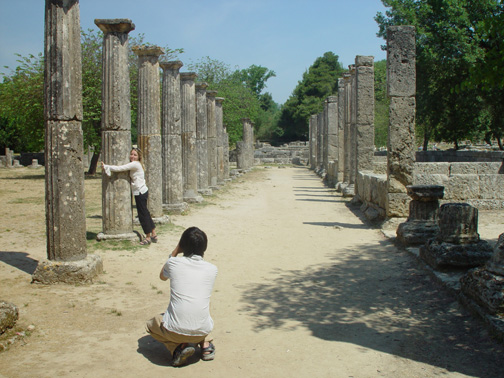
EXTRA POSTING: Sunday, 25 May 2003. OIA, Santorini.
We arrived to Santorini at 5:00 this morning after an uneventful eight-hour ferry ride from Pireas... and the rain, which was falling in Attica. The trip continues to unfold as expected. Everybody is settled down in our hotel in Oia. Tomorrow we will continue academic activities exploring the Museum in Fira, which will be followed on Tuesday and Wednesday with visits to Akrotiri and to Alta Thira respectively. There are more detail postings and images coming late today or tomorrow.
RLC
Here they are:
POSTING: Olympia, Sunday 18 May 2003
After surviving the night at our "Hotel California" in Olympia we awoke and were ready to hit the road at our usual 9:00am. A few minutes away was the Sanctuary of Olympia where we spent our morning. After Ricardo's usual guided tour of the site we were on our own to sketch and postulate about the Sanctuary's composing structures. Some of us devoted some time to theorizing with Ricardo about the entasis of the very first Olympic Stadium while others scouted out shady areas to sketch. A large portion of the group was enamoured by the perfectly laid out fallen columns of the Temple of Zeus while others were inspired by Phidias' Atelier or the serenity of the Palestra. Needless to say that everyone found something about the site that spoke to them.
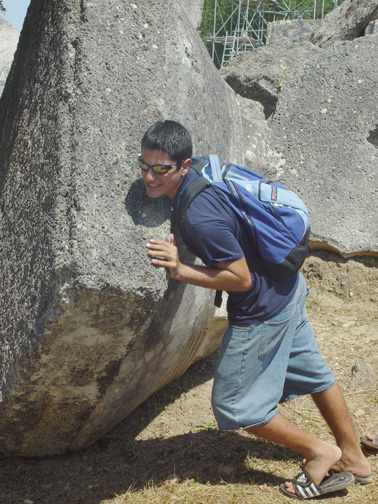
Olympia's museum was of course closed which is something we have gotten used to hearing. At noon we were back on the bus and ready for the long haul towards Mani. The majority of the trip was relaxing for most but a little too win! ding for others. Just as some of us were about to lose our Olympian lunches we had reached outr final destination.
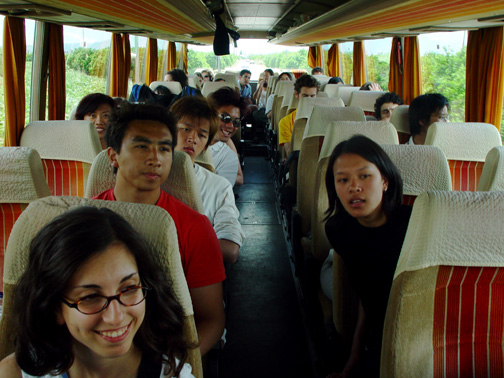
The Hotel Limeni Village is by far the nicest place we have laid down our baggage thus far. Set on a secluded bay upon the steep slopes of Mani, every room has a spectacular view of the surrounding landscape. After the customary "scoping out" of eachothers accomodations (some equiped with kitchens) we met for our 7:00pm meeting on the lobby terrace as the sun set over the glimmering sea. Dinner was dispersed around the hotel. Some used the hotel's kitchen facilities, some tried the Limeni menu and others feasted on Olympian canned goods purchased earlier. After dinner some of us caught a movie (The Mothman Prophecies) but few lasted to the end. After all, we needed our rest for the next day's national holiday.
Dave Brooks

MANI
POSTING. Mani, Monday, 19 May 2003
Perfect repose is not easily obtained, and when found is typically fleeting.
Often we have to make an effort to create peace and can maintain it only by barrickading ourselves from all else, and all else has a way of getting in. And so, along with fleeting, our typical repose is also solitary. Here in Manni however, I think we have all found repose and it is a communal one, an effortless one, and one that shows no signs of failing. After two busy weeks of travel, everyone immediately percieved the great potential of this place for giving a very welcome peace. Together we fell directly into an easy rhythm of food, sun, water and talk, and in this one day divided between terraces and beach, have already taken full advantage of the pleasant setting and given life to our hillside village.
The repose we have found here among the mountains and ocean is more than an escape from daily concerns however. In our retreat, we are free to concentrate on details, and everything in Manni stands out in bright clarity. The sun governs our day, the shade has become an enveloping shelter, and beneath the surface of the sea hides a playful world waiting to be explored. In Mani, we are able to re-discover and re-affirm what we enjoy and why. Though I would not presume that we can rebuild a Mani anywhere, I think it important that we as young architects carry its essence with us and reflect upon this place where sandals and a bathing suit are all we need to be content.
Noah Ives
POSTING. Mani, Tuesday, 20 May 2003
A week has passed since leaving Aegina. Although with the amount we've done it feels like longer (one delicious moment following another) the meaning saddens: that much less of the trip to go.
I awoke this morning to another beautiful day. The sun was shining at my doorstep and the sea breeze was calling. As it turned out, the